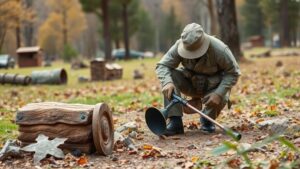Unearthing Coins and Jewelry in Forgotten Urban Gardens
Unearthing Coins and Jewelry in Forgotten Urban Gardens
The allure of urban gardens, often overlooked in bustling cities, lies not only in their beauty but also in their rich history. These green spaces serve as living time capsules, concealing artifacts of our past, including coins and jewelry. This article delves into the world of metal detecting in these forgotten urban gardens, encompassing historical significance, techniques for unearthing treasures, and the cultural implications of these discoveries.
The Historical Significance of Urban Gardens
Urban gardens have been integral to city life for centuries, evolving from essential food sources to cultural and recreational spaces. Historical records indicate that gardens were prevalent in ancient Rome, where they provided not only sustenance but also served as sites for social gatherings. Today, these gardens can reflect the socioeconomic changes that cities undergo over time, marking transitions in urban planning and community engagement.
For example, in New York City, many gardens were established in the 1970s as a response to urban decay, leading to a revival of neighborhood solidarity. As these sites flourished, they also became repositories of everyday objects, including lost coins and jewelry. According to the New York City Department of Parks & Recreation, there are over 600 community gardens across the city, many of which are ripe for discovery by metal detecting enthusiasts.
Techniques for Unearthing Treasures
Metal detecting in urban gardens requires both skill and knowledge of the local terrain. The initial step involves conducting thorough research on the history of the specific garden. The following techniques can enhance the treasure-hunting experience:
- Use of Appropriate Equipment: A high-quality metal detector is essential. Many enthusiasts recommend models such as the Garrett AT Pro or the Minelab Equinox, which are well-suited for diverse terrains.
- Understanding Soil Composition: Familiarize yourself with the garden’s soil type. Sandy soils may yield different results compared to clay or loamy soils, which can affect the detectors effectiveness.
- Timing and Weather Conditions: Metal detecting is often more successful after rain, which helps to loosen soil and may push buried items closer to the surface.
Real-world examples illuminate the potential treasures hidden beneath these gardens. In 2015, a community garden in Philadelphia yielded a cache of Civil War-era coins, thanks to an enthusiastic local historian with a metal detector. Similarly, in Chicagos community gardens, over 50 pieces of vintage jewelry were uncovered, some dating back to the 1920s.
Cultural Implications of Discoveries
The act of unearthing coins and jewelry in urban gardens extends beyond mere hobby–it has cultural and social implications. Such discoveries can foster community engagement by connecting individuals to their history and heritage. For example, coins often carry inscriptions that tell stories about past economies and cultures, while jewelry may reflect personal histories, cultural identities, or fashion trends of bygone eras.
Also, these findings can inspire local educational initiatives. Community groups can organize workshops to teach residents about the historical context of their discoveries, merging archaeology with community bonding. An illustrative case is the “Digging Into History” project held in Toronto, where artifacts from community gardens were displayed in local museums, bridging the gap between urban spaces and historical narratives.
Addressing Potential Questions and Concerns
Engaging in metal detecting in urban gardens can raise several questions and concerns, particularly regarding legality, ethics, and environmental stewardship.
- Legal Considerations: Always verify local regulations regarding metal detecting. In some municipalities, special permits may be required, and disturbing community gardens without permission can lead to legal repercussions.
- Ethical Practices: It is crucial to respect the environment and the intentions of garden spaces. Always obtain permission from the landowner or community to conduct metal searching.
- Preserving the Site: Upon finding artifacts, consider reporting them to historians or local societies to ensure they are preserved and appreciated in the broader historical context.
Actionable Takeaways
Unearthing coins and jewelry in forgotten urban gardens offers a fascinating glimpse into the past while enriching our understanding of local history. To embark on this rewarding journey, consider these actionable takeaways:
- Research the history of local urban gardens to identify promising sites.
- Invest in a quality metal detector and familiarize yourself with its functions.
- Engage with local communities to share your findings and learn from others.
- Always adhere to legal and ethical guidelines to maintain the integrity of urban spaces.
By honoring both the land and its history, metal detecting in urban gardens can be a fruitful endeavor that fosters a deeper appreciation for our shared cultural heritage.

